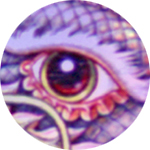
Originally Posted by
scholar

The three descriptors you've used are ways I could use to describe defensive, defensive/offensive and offensive aspects of Wu style training.
The first one involves taking some or all of the opponent's weight onto your foundation to lure him in to the point that where he expects the focus of his attack to manifest, he is instead flying past where he expected you to be and you are not hit. If you help him along past that focus with a foot sweep or a strike, he can easily be swept to the ground, but that involves adding an offensive technique to the originally purely defensive huà jìn 化勁 "neutralizing or transforming power." For the defensive to work, though, you have to meet the attack with internal stillness, which is to say without tensing up and telegraphing what you're about to do. You've got to be able to fool the other guy into thinking he's got you until it is too late for him to change. This is said to be the specialty of Wú Quányòu 吳全佑 (1834–1902) the first Wú family teacher, and subsequently all of his descendants, but I'm pretty sure it is (or was) universal to martial taijiquan.
The second description is something we work in the pushing hands quite a bit. "Left side full, right side empty" and vice versa or "upper half full, lower half empty" and vice versa if the attack is directly on the centerline. You get a punch coming in to your right side, you move that back at the same speed as the attack and at the same time the other side moves forward, for example. This shares features with your first example above, in that the target he expects to hit isn't there, but you hit him with your "full" side exactly when (or a split second before) he expects to hit you on your "empty."
The last one is purely offensive. In Hong Kong, Wú style is known as the "long arm" style. Because of the 45 degree forward lean in the bow stance, the reach goes quite a way out there, and many different aspects of àn 按, striking with the hand, zhǒu 肘, elbow or kào 靠, shoulder, are trained. This is for when you want to attack someone even if they aren't directly attacking you. Say, one day you see a pervert abducting a screaming kid into his windowless van...
So, we train these consistently. I don't know if other styles do the second two or not, I'd imagine so, but I'm not sure since besides Wú style I've only ever studied Yáng style for a few years almost 30 years ago, and that wasn't in any depth. I can say that to learn these skills involves a lot of getting hit and hitting the ground, over and over and over. Until you know how to do it, you don't know how to do it, and you'll have to endure being kicked around real good by senior students for years if you want to learn it for real. How else could you? If you want to neutralize a real punch, you have to work with a real punch. This is where most (but not all) taijiquan schools nowadays fall down. Even in my school where this stuff is emphasized, most people don't want to invest in the tedious work or face the embarrassment of being smacked around. Only a select few who have caught the bug and see the value of the old school curriculum that existed before hippies were ever even heard of dig into it.
Sūn Lùtáng 孫祿堂 (1860-1933) was the founding teacher of Sūn style taijiquan. Before he learned taijiquan he was already a long time practitioner of xingyiquan and baguazhang. From 1914 until 1928 he taught at the Beijing Physical Education Research Institute (Běijīng tǐyù yánjiù shè 北京體育研究社) with Wú Jiànquán 吳鑑泉 (1870-1942), Yáng Shǎohóu 楊少侯 (1862-1930) and Yáng Chéngfǔ 楊澄甫 (1883-1936). In the 14 year period Wú Jiànquán was working with Sūn on a daily basis I'm sure that a lot of technique was exchanged between them.



 Reply With Quote
Reply With Quote







